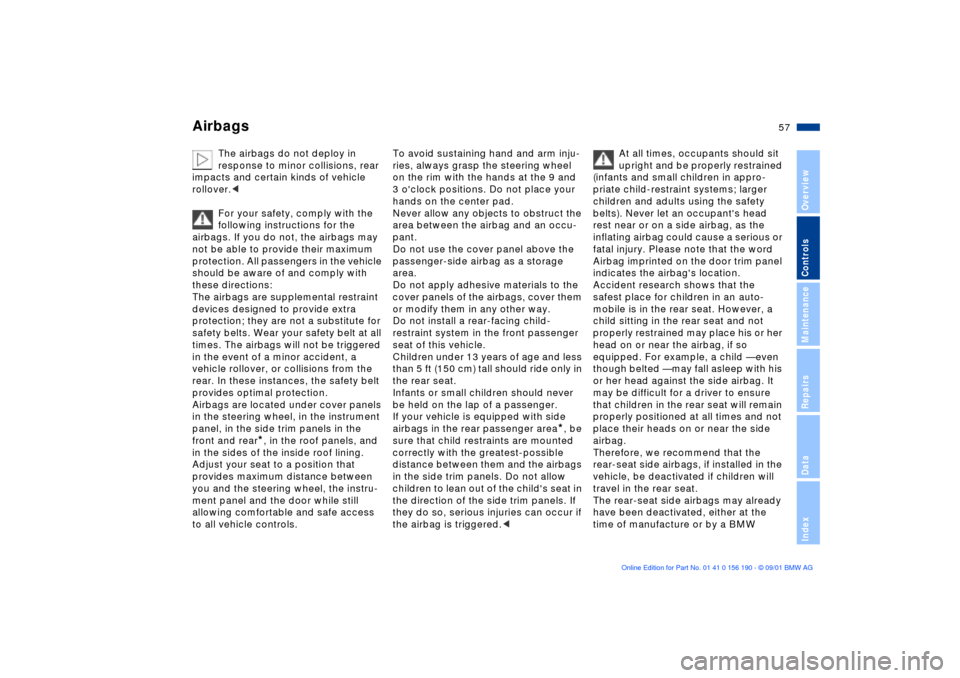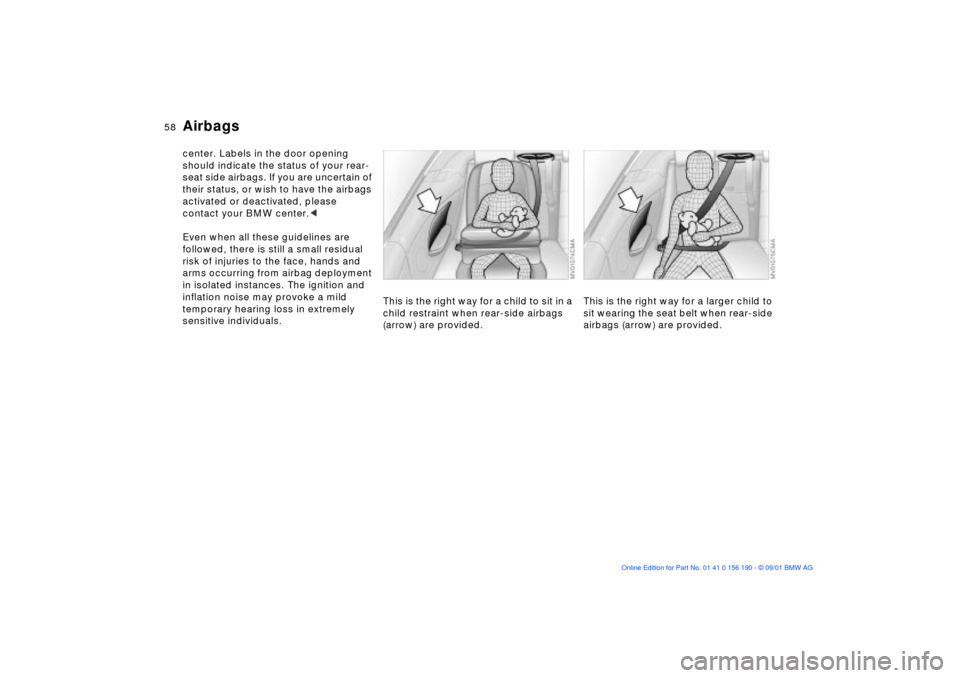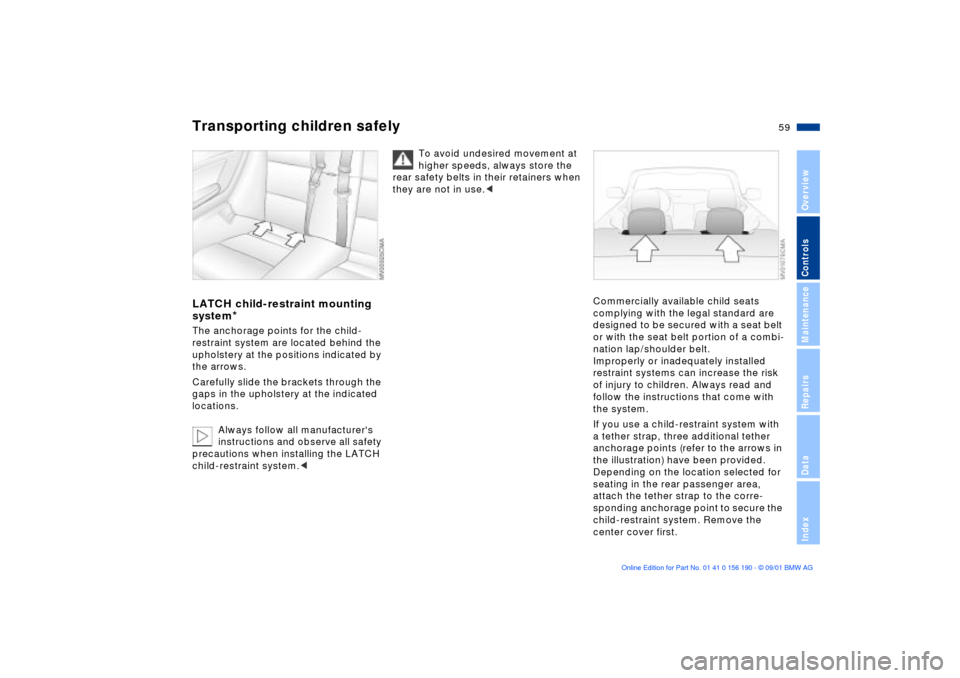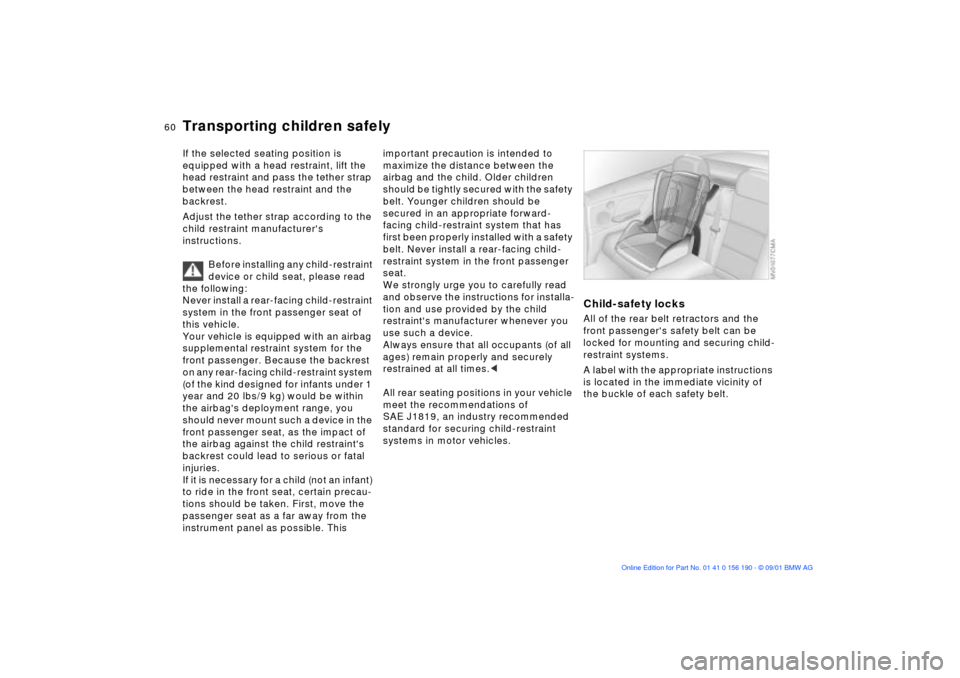2002 BMW 330Ci CONVERTIBLE child seat
[x] Cancel search: child seatPage 4 of 159

Contents
© 2001 Bayerische Motoren Werke
Aktiengesellschaft
Munich, Germany
Reprinting, including excerpts, only with the
written consent of BMW AG, Munich.
Order No. 01 41 0 156 190
US English VIII/01
Printed in Germany
Printed on environmentally friendly paper
(bleached without chlorine, suitable for recycling).
Overview
Controls and features
Cockpit14
Instrument cluster15
Indicator and warning lamps17
Multifunction steering wheel
(MFL)21
Hazard warning triangle22
Refueling22
Fuel specifications23
Tire inflation pressures24
Opening and closing:
Keys28
Central locking system28
Opening and closing
Ð via the remote control29
Ð via the door lock31
Ð from the inside32
Luggage compartment lid33
Luggage compartment35
Alarm system36
Electric power windows38
Manual convertible top39
Fully-automatic convertible
top42
Wind deflector46
Adjustments:
Correct sitting posture48
Seats48
Adjusting electric power
seats49
Lumbar support50
Head restraints50
Entering the rear51
Safety belts52
Seat and mirror memory53
Seat heating54
Steering wheel54
Mirrors55
Passenger safety systems:
Airbags56
Transporting children safely59Rollover protection system61
Vehicle Memory, Key
Memory63
Driving:
Ignition lock64
Starting the engine64
Switching off the engine65
Parking brake66
Manual transmission66
Automatic transmission with
Steptronic67
Indicator/Headlamp flasher69
Washer/Wiper system/
Rain sensor70
Cruise control72
Everything under control:
Odometer74
Tachometer74
Energy control74
Fuel gauge75
Temperature gauge75
Service Interval Display75
Check Control76
Computer76
Technology for safety and
driving convenience:
Park Distance Control (PDC)79
Automatic Stability Control plus
Traction (ASC+T)80
Contents
Page 48 of 159

48n
Correct sitting posture SeatsFor relaxed and fatigue-free driving you
should select a sitting position that
reflects your personal requirements.
Correct posture combines with safety
belts and airbags to enhance occupant
safety in the event of an accident. To
ensure that the vehicle's safety systems
provide you with optimal protection, we
request that you direct your careful
attention to the following section.
For supplementary information on
transporting children refer to page 59. Sitting correctly with airbags
Always maintain an adequate
distance between yourself and the
airbags. Always hold the steering wheel
by the rim to keep any chance of injury
to hands or arms to an absolute
minimum should the airbag be
deployed. Never allow any objects,
individuals or animals to obstruct the
areas between passengers and airbags.
Never use the front airbag's cover as a
storage tray or support for objects of
any kind. Never allow front passengers
to rest their feet or legs on the airbag
cover.<
For airbag locations and additional
information on airbags refer to page 56.
Safe with safety belts
Never allow more than one person
to wear a single safety belt. Never
allow infants or small children to ride in
a passenger's lap. Avoid twisting the
belt while routing it firmly across the
hips and shoulder, wear it as snugly
against your body as possible. Do not
allow the belt to rest against hard or
fragile objects. Do not route the belt
across your neck, or run it across sharp
edges. Be sure that the belt does not
become caught or jammed. Avoid
wearing bulky clothing and pull on the
lap belt periodically to retension it over
your shoulders. In the event of a frontal
impact, a loose lap belt could slide over
your hips, leading to abdominal injury.
In addition, the safety belt's restraint
effectiveness is reduced if it is worn
loosely. Expectant mothers should
always wear their safety belts, taking
care to position the lap belt against the
lower hips, where it will not exert pres-
sure against the abdominal area.<
For information on using the safety
belts refer to page 52.
When adjusting your seat, always
observe the following precautions
Never try to adjust your seat while
operating the vehicle. The seat
could respond with unexpected move-
ment, and the ensuing loss of vehicle
control could lead to an accident. Never
ride with the backrest reclined to an
extreme horizontal angle (important for
front passengers to remember). Keep
the backrest relatively upright to mini-
mize the risk of sliding under the safety
belt and sustaining injury in an acci-
dent.<
Seat adjustment>Power seat, refer to page 49
>Head restraint, refer to page 50
>Entering the rear, refer to page 51
Page 57 of 159

57n
OverviewControlsMaintenanceRepairsDataIndex
Airbags
The airbags do not deploy in
response to minor collisions, rear
impacts and certain kinds of vehicle
rollover.<
For your safety, comply with the
following instructions for the
airbags. If you do not, the airbags may
not be able to provide their maximum
protection. All passengers in the vehicle
should be aware of and comply with
these directions:
The airbags are supplemental restraint
devices designed to provide extra
protection; they are not a substitute for
safety belts. Wear your safety belt at all
times. The airbags will not be triggered
in the event of a minor accident, a
vehicle rollover, or collisions from the
rear. In these instances, the safety belt
provides optimal protection.
Airbags are located under cover panels
in the steering wheel, in the instrument
panel, in the side trim panels in the
front and rear
*, in the roof panels, and
in the sides of the inside roof lining.
Adjust your seat to a position that
provides maximum distance between
you and the steering wheel, the instru-
ment panel and the door while still
allowing comfortable and safe access
to all vehicle controls.
To avoid sustaining hand and arm inju-
ries, always grasp the steering wheel
on the rim with the hands at the 9 and
3 o'clock positions. Do not place your
hands on the center pad.
Never allow any objects to obstruct the
area between the airbag and an occu-
pant.
Do not use the cover panel above the
passenger-side airbag as a storage
area.
Do not apply adhesive materials to the
cover panels of the airbags, cover them
or modify them in any other way.
Do not install a rear-facing child-
restraint system in the front passenger
seat of this vehicle.
Children under 13 years of age and less
than 5 ft (150 cm) tall should ride only in
the rear seat.
Infants or small children should never
be held on the lap of a passenger.
If your vehicle is equipped with side
airbags in the rear passenger area
*, be
sure that child restraints are mounted
correctly with the greatest-possible
distance between them and the airbags
in the side trim panels. Do not allow
children to lean out of the child's seat in
the direction of the side trim panels. If
they do so, serious injuries can occur if
the airbag is triggered.
(infants and small children in appro-
priate child-restraint systems; larger
children and adults using the safety
belts). Never let an occupant's head
rest near or on a side airbag, as the
inflating airbag could cause a serious or
fatal injury. Please note that the word
Airbag imprinted on the door trim panel
indicates the airbag's location.
Accident research shows that the
safest place for children in an auto-
mobile is in the rear seat. However, a
child sitting in the rear seat and not
properly restrained may place his or her
head on or near the airbag, if so
equipped. For example, a child Ñ even
though belted Ñ may fall asleep with his
or her head against the side airbag. It
may be difficult for a driver to ensure
that children in the rear seat will remain
properly positioned at all times and not
place their heads on or near the side
airbag.
Therefore, we recommend that the
rear-seat side airbags, if installed in the
vehicle, be deactivated if children will
travel in the rear seat.
The rear-seat side airbags may already
have been deactivated, either at the
time of manufacture or by a BMW
Page 58 of 159

58n
Airbagscenter. Labels in the door opening
should indicate the status of your rear-
seat side airbags. If you are uncertain of
their status, or wish to have the airbags
activated or deactivated, please
contact your BMW center.<
Even when all these guidelines are
followed, there is still a small residual
risk of injuries to the face, hands and
arms occurring from airbag deployment
in isolated instances. The ignition and
inflation noise may provoke a mild
temporary hearing loss in extremely
sensitive individuals.This is the right way for a child to sit in a
child restraint when rear-side airbags
(arrow) are provided.
This is the right way for a larger child to
sit wearing the seat belt when rear-side
airbags (arrow) are provided.
Page 59 of 159

59n
OverviewControlsMaintenanceRepairsDataIndex
Transporting children safelyLATCH child-restraint mounting
system
*
The anchorage points for the child-
restraint system are located behind the
upholstery at the positions indicated by
the arrows.
Carefully slide the brackets through the
gaps in the upholstery at the indicated
locations.
Always follow all manufacturer's
instructions and observe all safety
precautions when installing the LATCH
child-restraint system.<
To avoid undesired movement at
higher speeds, always store the
rear safety belts in their retainers when
they are not in use.<
Commercially available child seats
complying with the legal standard are
designed to be secured with a seat belt
or with the seat belt portion of a combi-
nation lap/shoulder belt.
Improperly or inadequately installed
restraint systems can increase the risk
of injury to children. Always read and
follow the instructions that come with
the system.
If you use a child-restraint system with
a tether strap, three additional tether
anchorage points (refer to the arrows in
the illustration) have been provided.
Depending on the location selected for
seating in the rear passenger area,
attach the tether strap to the corre-
sponding anchorage point to secure the
child-restraint system. Remove the
center cover first.
Page 60 of 159

60n
Transporting children safelyIf the selected seating position is
equipped with a head restraint, lift the
head restraint and pass the tether strap
between the head restraint and the
backrest.
Adjust the tether strap according to the
child restraint manufacturer's
instructions.
Before installing any child-restraint
device or child seat, please read
the following:
Never install a rear-facing child-restraint
system in the front passenger seat of
this vehicle.
Your vehicle is equipped with an airbag
supplemental restraint system for the
front passenger. Because the backrest
on any rear-facing child-restraint system
(of the kind designed for infants under 1
year and 20 lbs/9 kg) would be within
the airbag's deployment range, you
should never mount such a device in the
front passenger seat, as the impact of
the airbag against the child restraint's
backrest could lead to serious or fatal
injuries.
If it is necessary for a child (not an infant)
to ride in the front seat, certain precau-
tions should be taken. First, move the
passenger seat as a far away from the
instrument panel as possible. This
important precaution is intended to
maximize the distance between the
airbag and the child. Older children
should be tightly secured with the safety
belt. Younger children should be
secured in an appropriate forward-
facing child-restraint system that has
first been properly installed with a safety
belt. Never install a rear-facing child-
restraint system in the front passenger
seat.
We strongly urge you to carefully read
and observe the instructions for installa-
tion and use provided by the child
restraint's manufacturer whenever you
use such a device.
Always ensure that all occupants (of all
ages) remain properly and securely
restrained at all times.<
All rear seating positions in your vehicle
meet the recommendations of
SAE J1819, an industry recommended
standard for securing child-restraint
systems in motor vehicles.
Child-safety locksAll of the rear belt retractors and the
front passenger's safety belt can be
locked for mounting and securing child-
restraint systems.
A label with the appropriate instructions
is located in the immediate vicinity of
the buckle of each safety belt.
Page 61 of 159

61n
OverviewControlsMaintenanceRepairsDataIndex
Transporting children safelyRollover protection systemTo lock the safety beltExtract the entire length of the belt from
the inertia reel mechanism. Allow the
reel to retract the belt somewhat and
engage the buckle, then tighten the belt
against the child-restraint system. The
retraction mechanism is now locked.
The belt cannot be extracted further.
Always observe the installation instruc-
tions provided by the manufacturer of
the child-restraint system.To release the safety beltRelease the safety belt, remove the
child's seat and retract the safety belt to
its end position on the belt retractor.In the event of an accident or some
other critical driving situation (extreme
tilting in the longitudinal or transverse
axis, loss of contact with the ground),
the rollover protection system will be
automatically activated. The protective
bars located in the rear head restraints
extend within fractions of a second.
In addition to the integrated rollover bar
in the windshield frame, the rollover
protection system affords all the vehicle
occupants necessary headroom.
Always keep the travel path for the
rollover protection system free
and clear. Under no circumstances
should you cover the head restraints.
In the event of less serious accidents,
the safety belt will protect you and,
depending on the severity of the acci-
dent, so will the safety belt tensioner
and the multi-stage airbag restraint
system as well.<
If, after being automatically triggered,
its protective function is not needed,
then the rollover protection system can
be lowered back into place. No special
tool is needed for this.
1. Using a screwdriver from the on-
board tool kit, remove the cover
panel; to do this, position the screw-
driver under the notch (arrow)
Page 153 of 159

Everything from A to Z
153n
OverviewControlsMaintenanceRepairsDataIndex
G
Garage-door opener97
Gasoline gauge75
Glove compartment97
Gross vehicle weight146 H
Handbrake66
Hands-free system100
microphone100
Hardtop110
Hazard warning triangle22
Head restraints50
Headlamp cover, care131
Headlamp flasher88
Headlamp washer
system120
capacity147
Headlight control87
Heated seats54
Heavy cargo103
Height145
High beams20, 69, 88
bulb replacement131
High Performance Synthetic
Oil122
Holder for canned
beverages100
Hood118
Horn14
I
Ice warning77
Icy roads77
Ignition keys28
Ignition lock64
Imprint4
Indicator lamps17
Inflation pressures,
tires24, 113
INSPECTION75
Instrument cluster15
Instrument lighting88
Instrument panel15
Interface socket for onboard
diagnostics (OBD)127
Interior lamps30, 89
remote control30
Interior motion sensor36
operating via remote
control30
switching off37
Interior rearview mirror55
with automatic
dimming56
Interlock64
J
Jack135
Jump-starting140 K
Key Memory63
Key set28
Keys28 L
Lamps and bulbs,
replacement131
Lashing eyes104
LATCH child-restraint
system59
Length145
License plate lamps, bulb
replacement134
LIGHTS ON warning87
Load-securing devices104
Lock buttons32
Low beams87
bulb replacement131
Lug wrench135
Luggage compartment35
capacity146
enlarging35
floor panel35
secure separately33 Luggage compartment lid
electrical malfunction33
manual operation33
operate via remote
control30
Luggage compartment
lighting33
Luggage compartment's
interior, emergency
release34
Luggage rack105
Lumbar support50
M
M+S tires117
Maintenance125
Malfunction displays76
Manual closing
fully-automatic convertible
top44
Manual convertible top39
close41
open39
Manual operation
doors31
fuel filler door22
luggage compartment
lid33